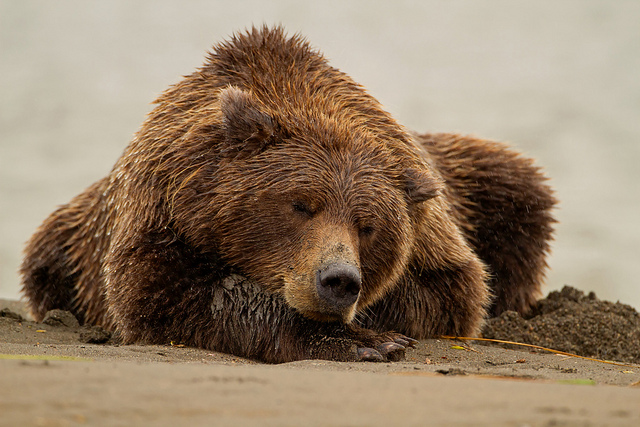News
March 2, 2016
By Nuritas
How Sleeping Bears May Save Your Muscles

Looking to Nature Series: 1
Authors: Claudia Colombo and Meaghan Lee-Erlandsen
As we are a company that looks to nature to uncover disease-beating ingredients, we are starting a new blog series that will focus on exciting new research that is exploring the world around us for answers to many of today’s health issues.
There are so many unknown aspects of the natural world that can help us live longer, healthier and happier and thus we at Nuritas™ think it is incredibly important to showcase how science is uncovering answers in nature that have been there for millions of years. Indeed, we haven’t had the tools to find or fully understand what’s been right under our noses for so long, until now.
To kick this series off, we thought we would start with the sometimes cuddly, sometimes ferocious (depending on if you have seen The Revenant or not), brown bear. Scientists are now looking to these particular bears to help in the fight against muscle loss which is at the center of tremendous health declines due to loss of mobility and dysfunctional metabolism rates leading to the onset of diabetes as well as many other diseases. In a nutshell, and very importantly, muscle health and maintenance is at the core of our wellbeing and its decline is associated with disease.
An innovative multidisciplinary team in association with the University of Strasbourg (France), led by biologist and chemist, Fabrice Bertile, is currently studying the characteristic of brown bears that is able to slow down muscle atrophy[1].
The main reason they are looking at bears in particular is because brown bears are hibernating animals. As most know, hibernation is usually defined as an inactive period characterized by not eating, drinking, defecating or urinating. The body temperature, metabolism, rate of breathing and heart rate are very low for these animals as they hibernate. Although their metabolism is partially inactive, Bertile and his team have found that brown bears present a particular feature in that they only lose 20% of their muscle mass during hibernation[2] which can last 5-7 months[3]. This is incredibly low compared to humans.
Indeed, Bertile et al. indicate that an immobilized human can lose on average 10% of his or her muscle mass after one month which can increase to 20 % after 3 months and so on and so forth[4]. This would mean during a similar 5-7 month period of immobilization a human without any medical intervention could lose between 50%-70% of their muscle mass which is incredibly problematic.
One recent study found even more astonishing results in that after only 60 days of immobility, young adult women lost 21% of the muscle volume in their triceps and 29% on their quadriceps[5].

Muscle loss in humans is caused by many different issues and is many times a by-product of illness and disease such as cancer and diabetes. After the age of 30 as well, the body’s composition naturally starts to change with a reduction in muscle mass of between 3-8% each decade[6]. This reduction in muscle mass severely declines as time goes on however and can reach more than 50% for those over 80 years of age[7].
As the elderly population is increasing globally and the rate of diagnosis for many illnesses such as cancer and diabetes increases, the muscle loss associated with aging and illness is causing a huge decline in overall health for a significant portion of the global population. Thus finding a treatment to mitigate or stop muscle loss altogether is quite an important aim and would help millions live more active and healthier lives.
To better understand this type of muscle loss, the researchers decided to compare protein muscle samples from brown bears during active and inactive periods. What they found was that the mechanisms which kept the muscular protein in tact possibly depended on factors which were circulating in the blood.
This is an exciting finding and as they begin the next phase of experimentation where they will identify, isolate and quantify these particular factors, the team will use a multidisciplinary approach, a combination of analytical chemistry, physiology and proteomics[8]. Their method consists of making a map of bear muscle proteins during active and inactive periods which they will then analyse using techniques such as mass spectrometry.
This research is very promising and may be able to lead to new treatments in fighting muscle loss and thus saving and enhancing many lives.
At Nuritas™, we are big fans of using groundbreaking multidisciplinary approaches to discover new and preventative treatments. We also know how important it is to look at the world around us and see what phenomenal evolutions have proven themselves in nature over millions of years and thus may help us in the fight against many diseases.
We look forward to new groundbreaking research such as this and will be back soon with another post on how science is looking to nature to uncover disease-fighting answers.
References:
[3] https://www.nwf.org/Wildlife/Wildlife-Library/Mammals/Grizzly-Bear.aspx
[5] http://www.ncbi.nlm.nih.gov/pubmed/17655736
[6] http://www.ncbi.nlm.nih.gov/pmc/articles/PMC3276215/





 Previous
Previous
